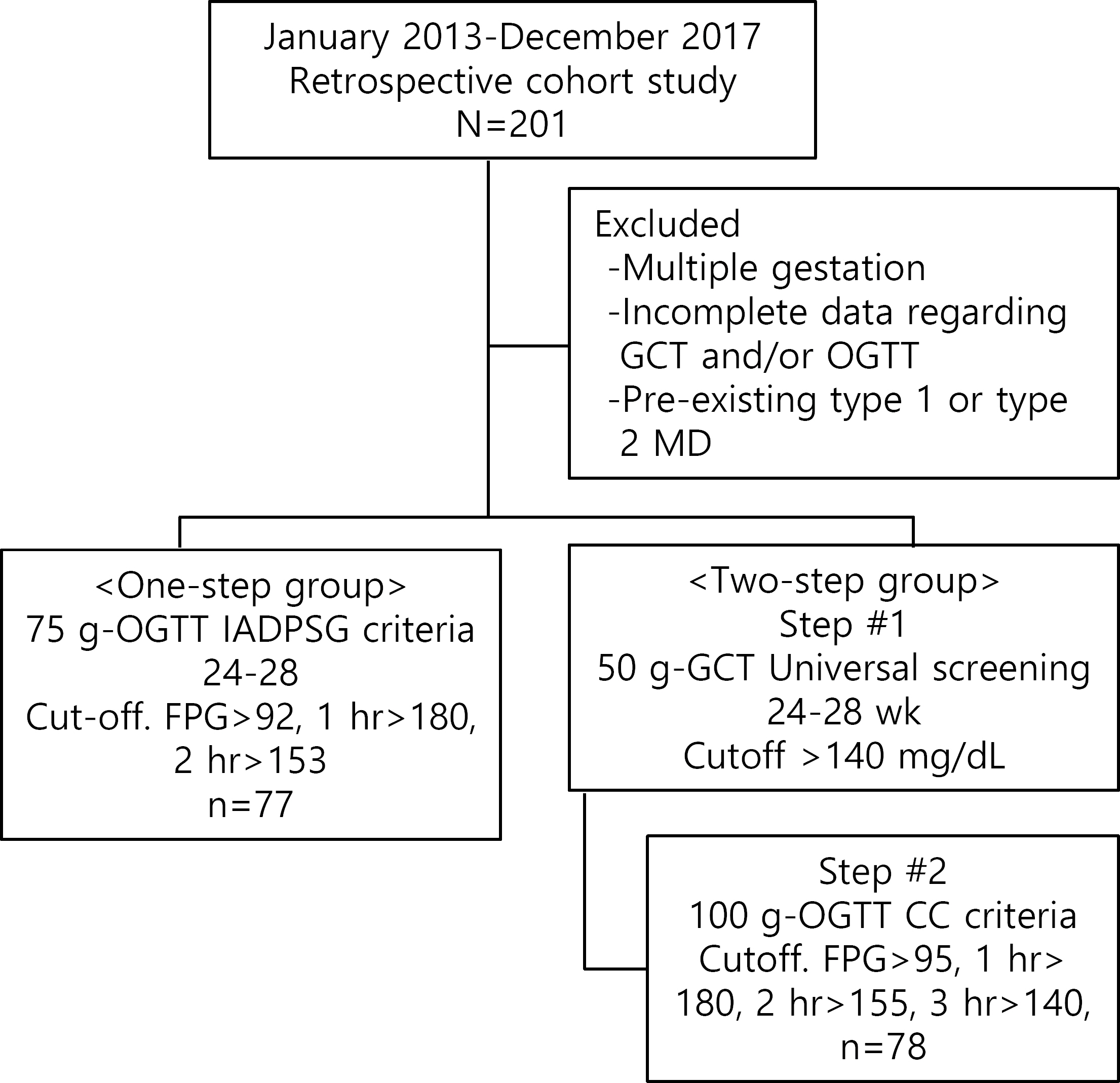J Korean Soc Matern Child Health.
2021 Jan;25(1):42-47. 10.21896/jksmch.2021.25.1.42.
Comparison of Pregnancy Prognosis for Gestational Diabetes Diagnosed by the 1-Step and 2-Step Methods
- Affiliations
-
- 1Department of Obstetrics and Gynecology, Ewha Womans University Medical Center, Seoul, Korea
- KMID: 2512483
- DOI: http://doi.org/10.21896/jksmch.2021.25.1.42
Abstract
- Purpose
To compare pregnancy complications between the 2 groups of patients with gestational diabetes mellitus (GDM): those diagnosed by the 1-step method and those diagnosed by the 2-step method.
Methods
In this retrospective cohort study, the data from outpatient and hospitalization medical records of 201 patients diagnosed with GDM between 2013 and 2017 were reviewed. We compared the pregnancy complications of these patients based on whether they were diagnosed by the 1-step or 2-step method. SPSS ver. 20.0 was used to analyze the data from the 2 groups. The odds ratio and 95% confidence interval of the pregnancy outcomes were estimated using binary logistic regression analysis.
Results
On comparing pregnancy-related complications between the groups, there was no significant difference in the incidence of preeclampsia or delivery by cesarean section (p>0.99 and p=0.50, respectively). In the 1-step and 2-step groups, the prevalence of premature birth was significantly high at 19.7 % and 40.3% (p=0.01), respectively. There were no significant differences between the 2 groups in terms of macrosomia, large for gestational age (LGA), small for gestational age (SGA), low APGAR score, and neonatal hypoglycemia (p>0.99, p>0.26, p>0.62, p>0.57, and p>0.45, respectively).
Conclusion
On comparing the 2 groups, we found that the 1-step and 2-step GDM groups had similar risks of pregnancy complications, namely preeclampsia, delivery by cesarean section, macrosomia, LGA, SGA, low APGAR scores, and neonatal hypoglycemia.
Figure
Reference
-
Abebe KZ., Scifres C., Simhan HN., Day N., Catalano P., Bodnar LM, et al. Comparison of two screening strategies for gestational diabetes (GDM2) trial: design and rationale. Contemp Clin Trials. 2017. 62:43–9.Benhalima K., Devlieger R., Van Assche A. Screening and management of gestational diabetes. Best Pract Res Clin Obstet Gynaecol. 2015. 29:339–49.Caissutti C., Berghella V. Scientific evidence for different options for GDM screening and management: controversies and review of the literature. Biomed Res Int. 2017. 2017:2746471.Caissutti C., Khalifeh A., Saccone G., Berghella V. Are women positive for the one step but negative for the two step screening tests for gestational diabetes at higher risk for adverse outcomes? Acta Obstet Gynecol Scand. 2018. 97:122–34.Farrar D., Duley L., Dowswell T., Lawlor DA. Different strategies for diagnosing gestational diabetes to improve maternal and infant health. Cochrane Database Syst Rev. 2017. 8:CD007122.Ferrara A. Increasing prevalence of gestational diabetes mellitus: a public health perspective. Diabetes Care. 2007. 30(Suppl 2):S141–6.Kang HS., Lee H., Hyun M. Trends in diabetes mellitus during pregnancy: prevalence and health care utilization. J Korean Soc Matern Child Health. 2010. 14:170–80.Khalifeh A., Eckler R., Felder L., Saccone G., Caissutti C., Berghella V. One-step versus two-step diagnostic testing for gestational diabetes: a randomized controlled trial. J Matern Fetal Neonatal Med. 2020. 33:612–7.Koo BK., Lee JH., Kim J., Jang EJ., Lee CH. Prevalence of gestational diabetes mellitus in Korea: a national health insurance database study. PLoS One. 2016. 11:e0153107.Luewan S., Bootchaingam P., Tongsong T. Comparison of the screening tests for gestational diabetes mellitus between “One-Step” and “Two-Step” methods among Thai pregnant women. Obstet Gynecol Int. 2018. 2018:1521794.Meltzer SJ., Snyder J., Penrod JR., Nudi M., Morin L. Gestational diabetes mellitus screening and diagnosis: a prospective randomised controlled trial comparing costs of one-step and two-step methods. BJOG. 2010. 117:407–15.Metzger BE., Gabbe SG., Persson B., Buchanan TA., Catalano PA., Damm P, et al. International association of diabetes and pregnancy study groups recommendations on the diagnosis and classification of hyperglycemia in pregnancy. Diabetes Care. 2010. 33:676–82.Metzger BE., Lowe LP., Dyer AR., Trimble ER., Chaovarindr U., Coustan DR, et al. Hyperglycemia and adverse pregnancy outcomes. N Engl J Med. 2008. 358:1991–2002.Nicolosi BF., Vernini JM., Costa RA., Magalhães CG., Rudge MVC., Corrente JE, et al. Maternal factors associated with hyperglycemia in pregnancy and perinatal outcomes: a Brazilian reference center cohort study. Diabetol Metab Syndr. 2020. 12:49.Saccone G., Caissutti C., Khalifeh A., Meltzer S., Scifres C., Simhan HN, et al. One step versus two step approach for gestational diabetes screening: systematic review and meta-analysis of the randomized trials. J Matern Fetal Neonatal Med. 2019. 32:1547–55.Sacks DA., Hadden DR., Maresh M., Deerochanawong C., Dyer AR., Metzger BE, et al. Frequency of gestational diabetes mellitus at collaborating centers based on IADPSG consensus panel-recommended criteria: the Hyperglycemia and Adverse Pregnancy Outcome (HAPO) Study. Diabetes Care. 2012. 35:526–8.Zhu Y., Zhang C. Prevalence of gestational deiabetes and risk of progression to type 2 diabetes: a global perspective. Curr Diab Rep. 2016. 16:7.
- Full Text Links
- Actions
-
Cited
- CITED
-
- Close
- Share
- Similar articles
-
- Gestational Diabetes Mellitus: Diagnostic Approaches and Maternal-Offspring Complications
- Gestational Diabetes Mellitus: Diagnosis and Glycemic Control
- Diagnosis and management of gestational diabetes mellitus
- Comparing the Efficiency of 75 gm Oral Glucose Tolerance Test to 100 gm Oral Glucose Tolerance Test in Diagnosing Gestational Diabetes in Korean Women
- Postprandial Free Fatty Acids at Mid-Pregnancy Increase the Risk of Large-for-Gestational-Age Newborns in Women with Gestational Diabetes Mellitus


